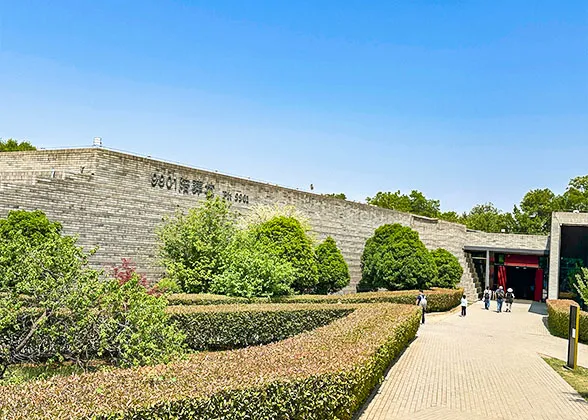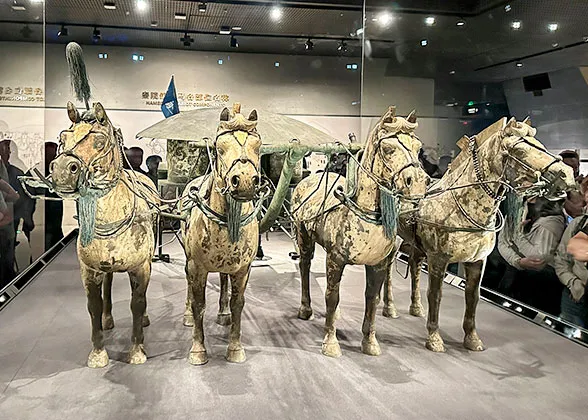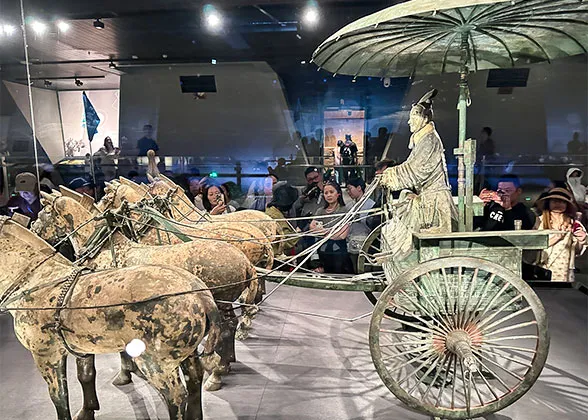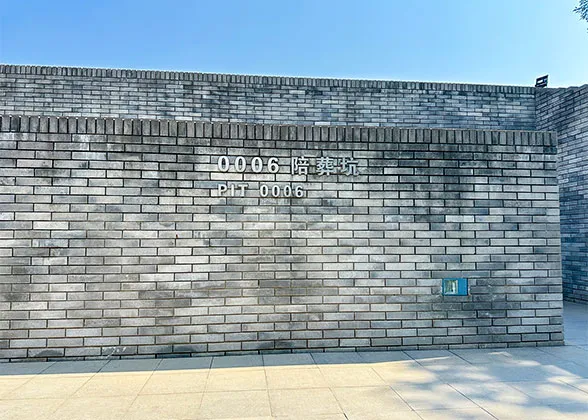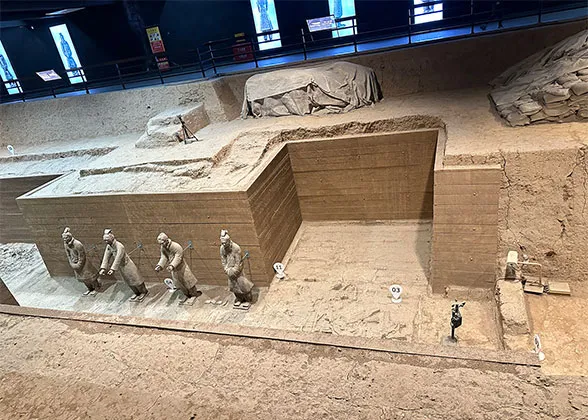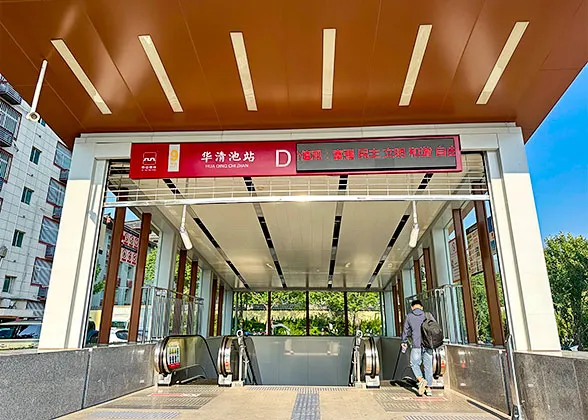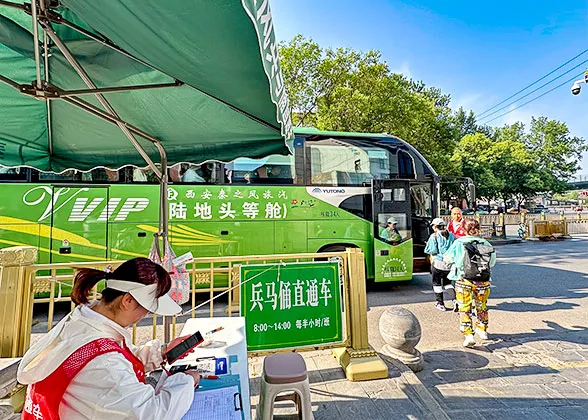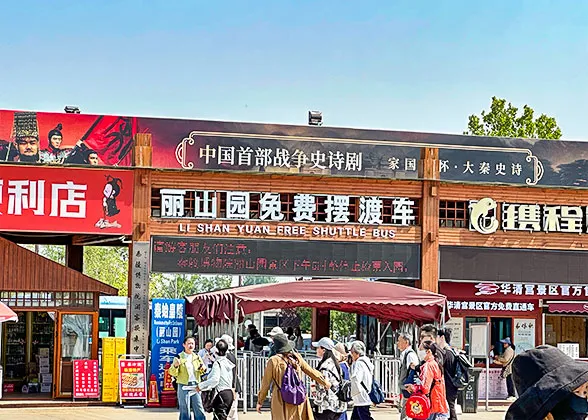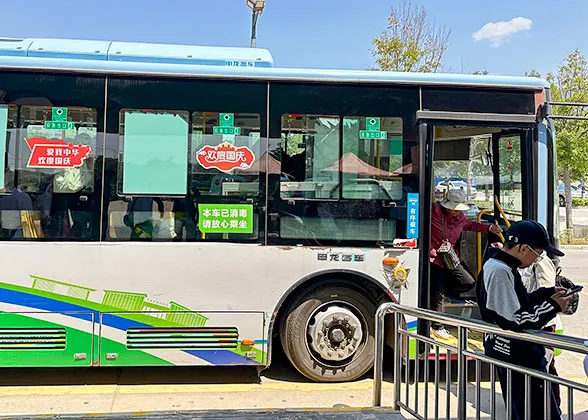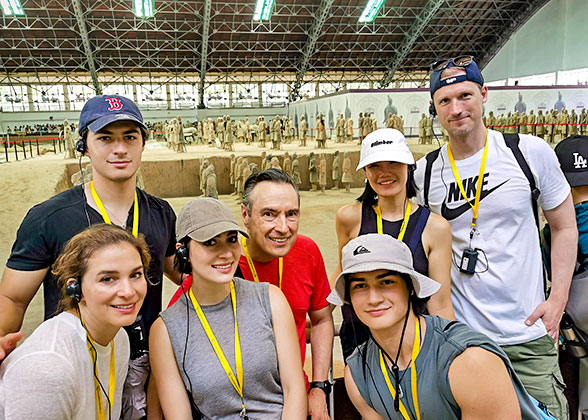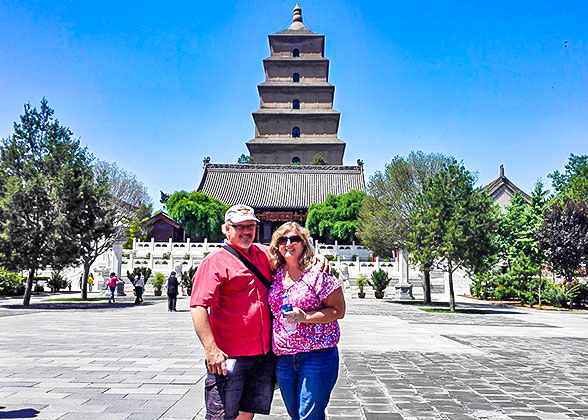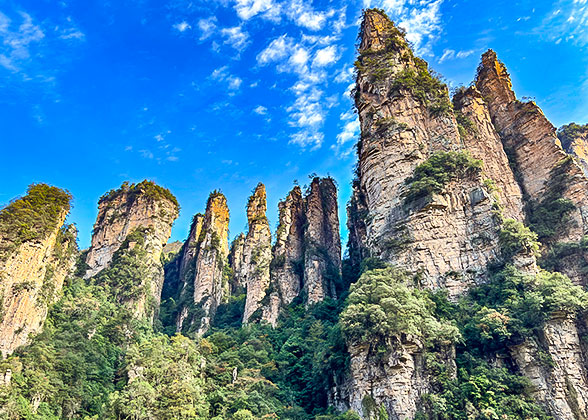Emperor Qinshihuang's Mausoleum Site Museum
Emperor Qinshihuang's Mausoleum Site Museum was built based on the Mausoleum of Emperor Qin Shi Huang, which was historically called Lishan Garden and is China's largest imperial tomb containing the richest burial objects. The site area contains the Museum of Terracotta Warriors and Horses of Qin Shi Huang and Qin Shi Huang's Mausoleum Site Park (Lishan Garden), which was built based on the discoveries from the mausoleum of the emperor.
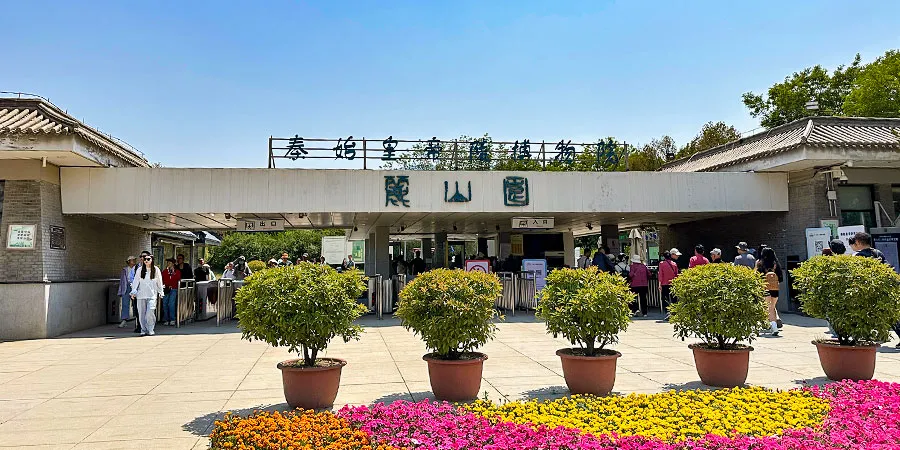 |
| Gate of Emperor Qin Shi Huang's Mausoleum Site Park |
Located 37 km (23 mi) east of Xi'an city, the Terracotta Army Museum is one of the greatest contemporary archaeological discoveries. It primarily consists of three excavation pits, including Pit 1, Pit 2, and Pit 3, as well as a cultural relics exhibition hall. With its large scale, great quantity, unsurpassed technique, and artistic value, the museum has attracted countless visitors since it opened.
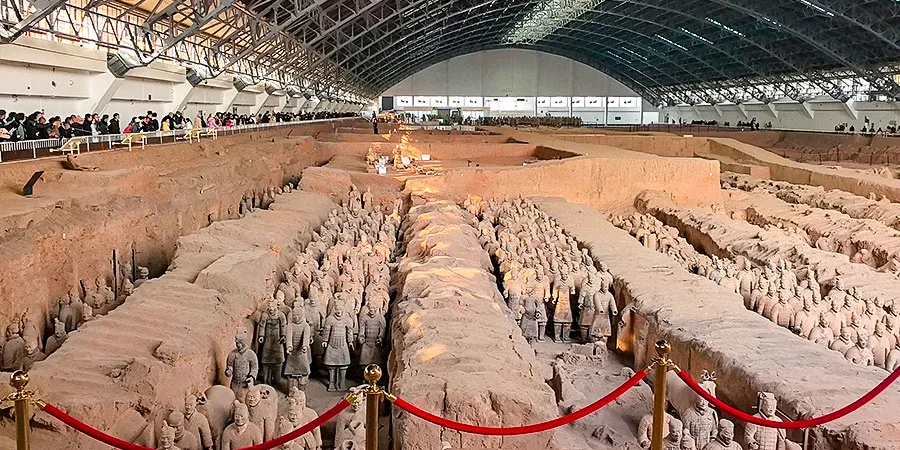 |
| Pit 1 of Terracotta Army Museum |
Qin Shi Huang's Mausoleum Site Park (Lishan Garden)
Lishan Garden, an integral part of the Emperor Qin Shi Huang's Mausoleum Site Museum, is a large archaeological park focused on preserving and displaying the Qin Shi Huang Mausoleum site. With an area of 226 hectares (about 558 acres), it features the tumulus of Qin Shi Huang Mausoleum, major archaeological sites that have been discovered, ritual sacrifice pits, the Museum of Terracotta Acrobatics, Museum of Terracotta Civil Officials, Museum of Stone Armor, and Museum of Bronze Chariot and Horse.
What to See in the Lishan Garden?
Excavated in 2011, Pit K9901 is also known as the "Acrobatics Figures Pit." "Acrobatics" refers to ancient performances combining music, dance, and stunts, which were a major form of court entertainment. Among more than 30 unearthed terracotta figures, the restored figures showcase both muscular and slender builds, suggesting that strength-based and skill-based acts existed in that time. Additionally, some terracotta figures, like the figure adorned with more than one hundred studded nails and the figure in a supine position, retain vivid, colorful paint and dynamic poses, offering a glimpse into Qin-era court performances. Moreover, cultural relics such as bronze tripods, pottery basins, and a melon-shaped stone tool that are suspected to be performance props were found in this pit. These discoveries reveal a new category of Qin terracotta warriors and present the dynasty's vibrant court life.
|
|
The Museum of Bronze Chariots and Horses is a dedicated archaeological museum showcasing two bronze chariots and horses. Regarded as China’s largest, most intricate, and best-preserved bronze chariots and horses, they are hailed as the "Crown of Bronze." Crafted at half the size of real chariots and horses in the Qin dynasty (221 - 207 BC), they exemplify imperial luxury and advanced craftsmanship, making them the most precious treasure of the museum. On the second floor of the museum, some replicas of components and ornaments of the chariots and horses are displayed, allowing close-up views of their exquisite details.
The two bronze chariots and horses were originally displayed at the Terracotta Army Museum. To emphasize the principle of displaying the cultural relics on their original excavation sites as much as possible, they were relocated to their current museum, just 240 meters (260 yards) from their excavation site.
The two bronze chariots and horses were originally displayed at the Terracotta Army Museum. To emphasize the principle of displaying the cultural relics on their original excavation sites as much as possible, they were relocated to their current museum, just 240 meters (260 yards) from their excavation site.
|
|
The Pit K0006, also known as the "Civil Officials Pit," is rare among Qin Shi Huang’s mausoleum pits for escaping fire damage. Covering an area of 410 square meters (490 square yards), it has a front chamber and a rear chamber. In the front chamber, there are eight official figures standing with hands clasped in sleeves, while four figures assume charioteer poses. In the rear chamber, only horse bones were found. The terracotta figures in this pit wear long caps that stand for noble rank. In contrast with the stern warrior figures in the Terracotta Army Museum, their serene expressions reflect the Qin civil official’s refined ethos.
|
|
4. Attractive Natural Landscapes
As a vast heritage park, the Lishan Garden features abundant greenery and ever-changing seasonal scenery. In spring, the entire park awakens with lush vegetation, while cherry blossoms in March and April add vibrant color to the quiet landscape. Summer brings dense shade from towering trees and the rhythmic songs of cicadas. Autumn transforms the garden into a painterly scene, with leaves turning golden yellow or fiery red, perfect for leisurely walks along paths covered with fallen foliage. In winter, snowfall turns the park into a white wonderland, inviting visitors to make snowmen or engage in spirited snowball fights.
 |
| Cherry blooms in Lishan Garden. |
When is the Best Time for a Visit?
The best time to visit is on weekdays during spring from March to May or in autumn from September to November for pleasant weather. Specifically, mornings are ideal to avoid peak tourist crowds heading to the Terracotta Army Museum, allowing for a more relaxed visit in the Lishan Garden.
How to Tour the Qin Shi Huang's Mausoleum Site Park?
1. Sightseeing Bus Tour - Most Popular Choice
After entering the Lishan Garden, you can purchase a ticket for a sightseeing bus on the left. The sightseeing bus follows a one-way route: Pit K9901 → Museum of Bronze Chariot and Horses & Pit K0006 Pit → The main mausoleum of Emperor Qin Shi Huang, before returning to the entrance. The entire tour takes about 1.5 to 2 hours with minimal walking, making it perfect for visitors with limited time, as well as families, especially those with children or elderly members, who prefer a comfortable and efficient experience.
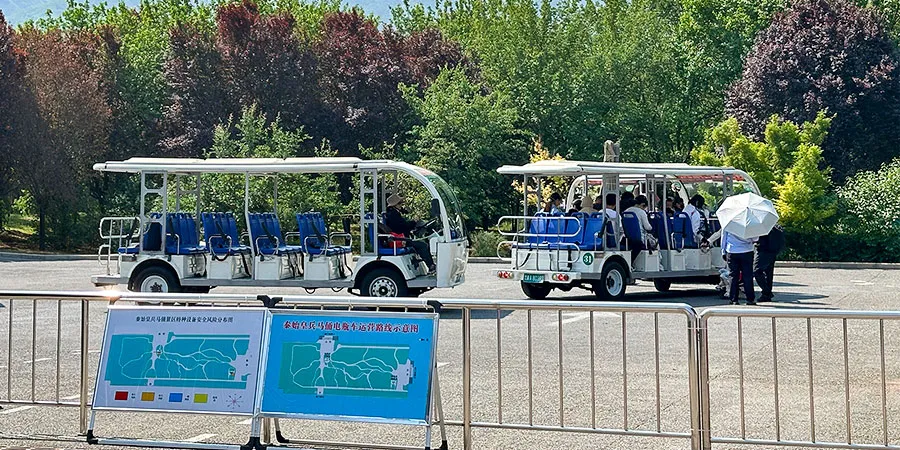 |
| Sightseeing Bus in Lishan Garden |
2. Combined Sightseeing Bus & Walking Tour
After riding to visit all three major exhibition sites, you can get off at the last stop.
From there, the exit is approximately a 10-minute walk away, and this area houses the tombstone of Emperor Qinshihuang's main mausoleum. Following your exploration, you can explore other areas of the park on foot before proceeding to the exit. This option balances convenience and deeper exploration, ideal for those who want to save energy while enjoying a more immersive visit.
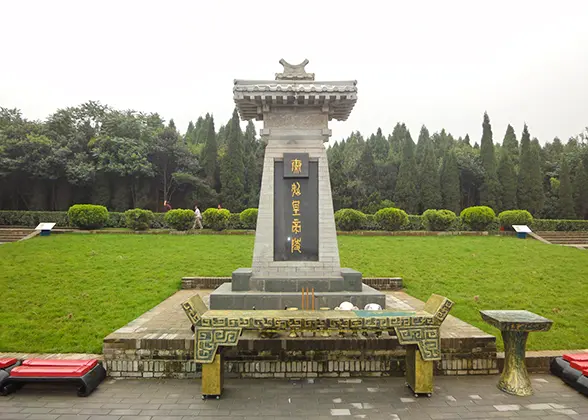 |
| Emperor Qin Shihuang's Mausoleum |
3. Walking Tour - Suitable for Hiking Enthusiasts
The Lishan Garden is expansive, and a full walking tour requires at least 4 hours, demanding good physical condition. However, the park’s scenic beauty and fresh air, especially in spring and autumn, make it rewarding and suitable for hiking lovers with ample time and those who enjoy the blend of nature and history.
You may like: How to Visit Terracotta Army - A Comprehensive Visitor's Guide?
| Tickets | Entrance fee: CNY 120, including the Museum of Qin Terracotta Warriors and Horses and Lishan Garden Sightseeing buses are available for an extra fare: CNY 5 to the Terracotta Army Museum and CNY 15 to Lishan Garden. |
|---|---|
| Recommended Visit Duration | 3 - 4 hours |
| Opening Hours | March 16 to November 15: 08:30-18:30, last admission at 17:00 November 16 to March 15: 08:30-18:00, last admission at 16:30 |
How to Get to Qin Shi Huang's Mausoleum Site Park?
Option 1. Downtown Xi'an → Terracotta Army → Lishan Garden
Step 1:From Downtown Xi'an to Terracotta Army
First, you can take the subway and city bus, which takes about 1.5 hours and costs CNY 10 - 15. Specifically, take Metro Line 9 to Huaqing Pool Station and then transfer to Lintong Bus 602 or 613 to the Terracotta Army.
Besides, you can take the direct tourist bus at the east gate of Yisushe Grand Theater near the Bell Tower or the Dayanta Vienna Hotel near the Giant Wild Goose Pagoda to arrive at the site. The one-way fare is CNY 30, with a travel time of about 1 hour.
|
|
Lastly, a taxi can be the most convenient and comfortable way. A single-way trip takes about an hour, and the fare is approximately CNY 160 - 220.
Detailed in How to Get to Terracotta Warriors from Xi'an?
Step 2: From the Terracotta Army to the Lishan Garden
Take the free shuttle bus near the Terracotta Army entrance, which takes about five minutes.
|
|
Option 2. Downtown Xi'an → Lishan Garden
To get directly from downtown Xi'an to Lishan Garden, you can take Metro Line 6 or Metro Line 1 to Fangzhicheng Station, transfer to Line 9 to Huaqing Pool Station, then take Lintong Bus 602 to Qin Shi Huang Ling (Qin Shi Huang Mausoleum) Station and walk southwest 470 meters (510 yards) to Lishan Garden.
If you take a taxi, set the destination to the east gate of the Lishan Garden, with a one-way trip of about an hour, and a fare ranging from CNY 160 to 230.
Tips for Visiting Qin Shi Huang's Mausoleum Site Park
1. The ticket for the sightseeing bus can only be purchased at the entrance.
2. The sightseeing bus runs a one-way route. The Museum of Bronze Chariots and Horses and Pit K0006 share the same stop, so don't miss either.
3. Arrive early to set aside enough time to visit the Lishan Garden. If you enter close to 17:00, the stop-entry time, there may be no sightseeing bus available.
4. The park is vast, and there are many steps in the exhibition halls, so it's recommended to wear comfortable and slip-resistant shoes.
Further Reading:
- Best Time to Visit Terracotta Army
- How to Buy Terracotta Warriors Tickets?
- Exhibition of Archaeological Discoveries
- Underground Palace of Qin Shi Huang Mausoleum
- Why Don’t They Excavate the Qin Shi Huang Mausoleum?
- Has Qin Shi Huang's Tomb ever been robbed in the past?
- 9 Mysteries of Qin Shi Huang Tomb You May Want to Know
Recommended Tours
- Last updated on Aug. 22, 2025 by Doris Xue -
